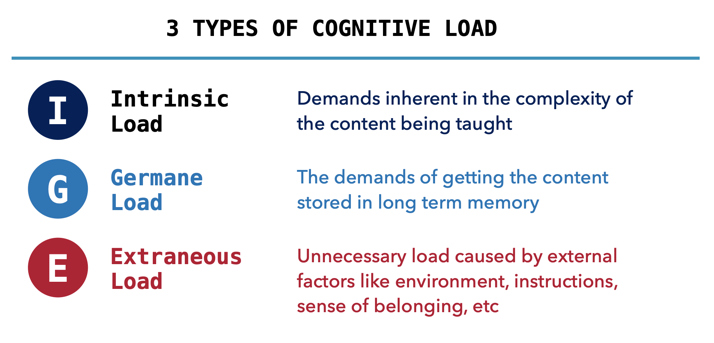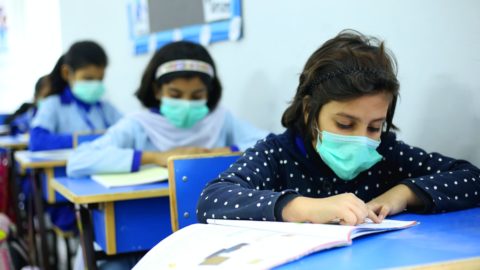In my own internal calendar, that mid-summer flip-the-page moment when I mentally move on to the next school year is signaled by the end of the Tour de France. As the lycra-clad cyclists ride off into the distance, I often pause to consider: “What one MBE principle is most on my radar right now?” There is one clear candidate for me this summer. When I think about the start of the year ahead, cognitive load theory dominates my mind.
In part, this is because cognitive load has been a constant companion in my thoughts all throughout these pandemic-affected school times. And not just the cognitive load of my students, but also the cognitive load of teachers, me very much included. At some point in the past 18 months, I think most of us have felt as though we are trying to hold too much in our heads at once.
This is the essence of cognitive load theory. And by understanding it, we can make simple changes to improve our classes.
Before thinking about cognitive load, though, let’s walk through this “simple model of learning,” based upon a classic image from Professor Dan Willingham in his book “Why Don’t Students Like School?”, the new edition of which has just been published.
A Simple Model of Learning

In very simple terms, some sensory information from the environment is selected and brought into our active working memory, which is illustrated by the arrow on the left. This is the role of our attention system.
The sensory information is held and manipulated in active working memory, along with information that has been retrieved from our long-term memory, which is symbolized by the arrow in the bottom right. Think of this arrow as remembering.
This new sensory information and remembered knowledge are combined and processed in our active working memory, which then writes organized schema back into our long-term memory, which is represented by the arrow in the top right. This is learning.
For learning to have occurred, schema – organized structures of factual and procedural knowledge – need to be written into long-term memory. If that hasn’t happened, even if I felt I was on fire teaching today’s lesson, learning has not occurred.
All through this process, things leak out – we don’t pay sufficient attention to the information, or the details fall out of our active working memory because it has very limited capacity, or robust schemas are not written into long-term memory. This is forgetting.
This system has a significant bottleneck, though – our active working memory, which can only hold three to five items at a time for 10-20 seconds. And while our working memory seems quite resilient to everyday variations in stress, acute stress and anxiety can worsen this performance. This is perhaps the reality that many children and adults face with all they have been living though in the past 18 months. If I am going to be a successful teacher, particularly this upcoming year, I need to manage the demands I place on my students’ active working memory. I need to be deliberate about doing this. If I am not, unnecessary forgetting will happen.
Cognitive Load Theory
The term cognitive load represents the demands that we are placing on our active working memory at a given time. John Sweller, in his Cognitive Load Theory, suggests that our cognitive capacity is finite, and that there are three types of cognitive load placed on it:

The critical piece here is germane load. Some of our finite cognitive capacity is used to write schema back into our long-term memory. If there is too much cognitive load, a student might be unable to do the task; maybe they even have that feeling that they are trying to hold too much in their head at once and bits keep spilling out. Or they may be able to do the task in the moment but, because they did not have the cognitive capacity to write it into their long-term memory, they were unable to do it later for homework, or the next day in class. It wasn’t learned. I had an epiphany when I learned about this. Cognitive load is often a barrier to learning, and one I can do something about.
Managing Intrinsic Load
There is little we can do about the intrinsic load, except to carefully design the curriculum so that children build critical knowledge and skills in their long-term memory as they go. By doing this we can reduce how much new information needs to be held in their active working memory at once. We can also use simple scaffolding to reduce the amount students need to hold in their active working memory at once. For example, allowing students to bring a notecard with quotations for the first in-class essay of the year so that they can focus on the mechanics of writing the essay. Or allowing students to use an equation sheet at the start of a unit on physics. Both these examples follow the first rule of scaffolds: they must be temporary – peeled back as a student’s proficiency increases.
Reducing Extraneous Load
There is more that we as teachers can do about extraneous load. Here are some simple examples:
- Make sure you give clear instructions. Number the steps, and limit sentences to 25 words or fewer. Simplify instructions by chunking text with subheadings. Vow to refresh some of your “classic” assignments this upcoming year to give better instructions.
- Avoid visual overwhelm in your classroom. Design your space, don’t decorate it. Everything should have a purpose connected to helping your students learn. As classroom space expert Dr. Robert Dillon says, “I have never been in a classroom that could not be made better by removing five objects.” So what five objects are you going to remove from your classroom for the new school year?
- Be mindful of audio distractions – at least the ones in your control. Use music tactically.
- Strive for consistency, and use the start of the year to set up these routines. For example, have students submit work in as few different ways as possible, and walk them through how this works. Have one routine and definitive place for posting homework. Have a clear system for how students can get in touch with you, and regularly remind students what it is. Show students how to access and use the feedback you give them.
- We have all experienced an abundance of EdTech tools this past year, but the idea of “the more tools the better” is a fallacy as each new tool carries a cognitive load. Find a core set of tools that work for you. Recognize when “no technology” or “technology-lite” are better options.
- Practice new EdTech tools and processes with no-stakes assignments.
- Sometimes, a video to help explain an assignment or to give feedback could reduce cognitive load. A simple low-budget video filmed on your phone or computer (I use Loom) is easy to make.
We could make this list much longer, but my goal is to sow seeds in your mind so that you can add to it.
Ever since I first learned about it, the words “cognitive load” have been buzzing in my head. Whenever I plan a class or assignment, or teach a lesson, my extraneous cognitive load radar is always up – where is it, and what can I do to reduce it? I constantly wonder whether my students have enough “spare” cognitive capacity for the germane load of learning, or if I need to come up with a plan B. I use formative assessments all the time in a diagnostic way to figure out what has stuck, what is still problematic for which students, and what might I do about this in future lessons.
As I look forward to the upcoming school year, I think I am going to need to ramp up my cognitive load radar a notch or two more. There is a lot on everyone’s mind. There may be some rocky days as we all find the rhythm of a unique school year. We will make it. Having cognitive load on your mind will help.
About the Author
Dr. Ian Kelleher is a science teacher at St. Andrew’s Episcopal School, and Head of Research for its Center for Transformative Teaching & Learning. His work focuses on helping teachers translate the science of learning into everyday practices in their own classrooms, and measuring the impact. Ian is the co-author of “Neuroteach: Brain Science and the Future of Education,” and co-designer of Neuroteach Global. Ian is the the inaugural Joseph and Kathleen Dreyfuss Faculty Chair for Research, an endowed position at St. Andrew’s Episcopal School for the lead CTTL researcher.




